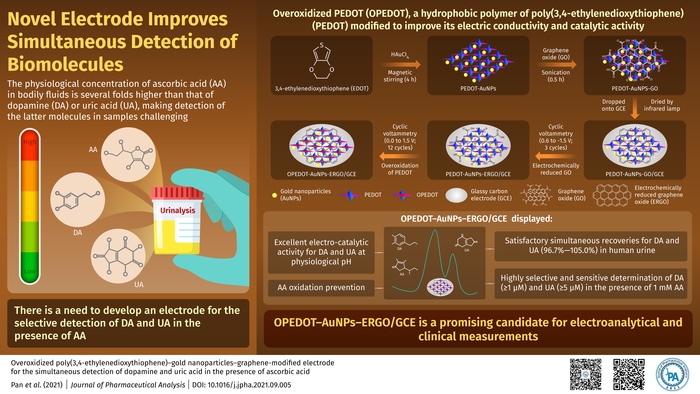The process of detecting and evaluating different pathophysiological components present in urine samples is known as urinalysis. It is routinely recommended by doctors for the diagnosis of diseases. For example, increased uric acid (UA) levels may be a sign of underlying heart or kidney disease.
 Researchers develop an efficient electroanalytical technique for the sensitive detection of substances in laboratory and clinical samples. Image Credit: Journal of Pharmaceutical Analysis.
Researchers develop an efficient electroanalytical technique for the sensitive detection of substances in laboratory and clinical samples. Image Credit: Journal of Pharmaceutical Analysis.
Likewise, an upsurge in the urinary levels of dopamine (DA) might be a sign of the presence of nervous disorders, such as Parkinson’s disease or neuroblastoma. As pathology laboratories must determine the urinary levels of several components simultaneously, methods permitting such co-detection are essential.
But such co-analyses present technical challenges at times. As far as the urine samples are concerned, comparatively higher ascorbic acid (AA) concentrations in urine interfere with the co-detection of UA and DA, both of which exist at comparatively lower levels.
A research team, headed by Associate Professor Dongdong Zhang of Xi’an Jiaotong University, China, has made it possible to overcome this drawback with a novel electroanalytical technique that allows the simultaneous detection of UA and DA in urine samples even in the AA’s presence.
The paper was published in December 2021, in the Journal of Pharmaceutical Analysis.
In the paper, the researchers explain how they integrated a nanocomposite mixture, with an average 10-9 m grain size or more, built of gold nanoparticles (AuNPs) — a special (conducting) polymer — and electrochemically-treated graphene oxide across a traditional glassy carbon electrode (GCE), to acquire a high-quality electrode for application in their technique.
A GCE integrates the properties of glass with properties of graphite. Nevertheless, it requires alteration for the simultaneous and selective detection of UA and DA in the existence of high concentrations of AA.
The researchers used a combination of electrochemical and chemical methods. They started with PEDOT, or poly(3,4-ethylenedioxythiophene) — a highly conductive polymer with much hope in the field of biosensors.
PEDOT can be overoxidized to obtain OPEDOT, whose hydrophilicity and unique properties make it useful in electroanalytical applications. However, since OPEDOT is not as good an electrical conductor or catalyst, it is modified with suitable nanomaterials, in this case, gold nanoparticles.
Dongdong Zhang, Researcher and Associate Professor, Xi’an Jiaotong University
The PEDOT-AuNPs were chemically produced at room temperature from chloroauric acid and 3,4-ethylenedioxythiophene. Adding graphene oxide (GO) resulted in the production of a homogeneous suspension of PEDOT-AuNPs-GO. Then, the suspension was dropped onto a GCE’s surface and dried.
Lastly, after an electrochemical procedure, the nanomaterial OPEDOT-AuNPs-ERGO/GCE was efficiently made and prepared for bioanalytical measurements.
The modified electrode was able to detect very small amounts of UA (5 mM) and DA (1 mM) under physiological conditions when used, even in the presence of a large amount (1.0 mM) of AA. This is quite an amazing observation.
The research team anticipates a great future for this new nanomaterial-based application, particularly in diagnostic and clinical setups.
Our novel, graphene-based, ternary composite, with its advantageous features, is a promising candidate for electroanalytical and clinical applications.
Dongdong Zhang, Researcher and Associate Professor, Xi’an Jiaotong University
Further studies are definitely required; however, this novel nanocomposite electrode has powerful potential to turn into the gold standard in pathology laboratories for diagnostics.
Journal Reference:
Pan, J., et al. (2022) Overoxidized poly(3,4-ethylenedioxythiophene)–gold nanoparticles–graphene-modified electrode for the simultaneous detection of dopamine and uric acid in the presence of ascorbic acid. Journal of Pharmaceutical Analysis. doi.org/10.1016/j.jpha.2021.09.005.